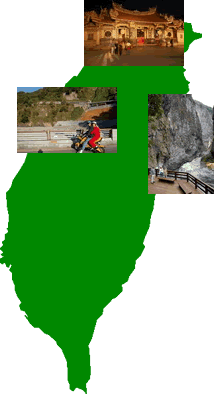
Taiwan 台灣

Two-thirds of the island of Taiwan's total area of 36,188 sq. km is covered in lush subtropical hills and high mountians. Located in the western Pacific between temperate Japan to the north, the tropical Philippines to the south, and subtropical southern China to the west, the island is about 394 km long and 144 km across at its widest point. With six mountain peaks over 3,500 meters and more than two hundred peaks with elevations of over 3,000 meters, Taiwan is the world's seventh-highest island.
The island has witnessed waves of colonization. The Dutch and the Spanish independently colonized parts of northern and southern Taiwan in the 17th century. The Ming dynasty (1368-1644) general Jheng Cheng-gong (鄭成功) defeated the Dutch and set up a government on Taiwan to defy the Manchus, who had established the Ching (清) (1644-1911) dynasty on the Chinese mainland. The Manchus conquered Taiwan in 1683 and ruled it until 1895, when Taiwan was ceded to Japan after the First Sino-Japanese War. At the end of World War II in 1945, Japan relinquished Taiwan, which in turn came to be ruled by the Republic of China (ROC).
The ROC's population is close to 23 million. About 98% of the population is of Han Chinese ethnicity. Of these, 86% are descendants of early Han immigrants known as "native Taiwanese" (本省人). This group contains two subgroups: the Southern Fujianese or "Hokkien" or "Min-nan" (70% of the total population), who migrated from the coastal Southern Fujian (Min-nan) region in the southeast of Mainland China; and the Hakka (15% of the total population), who originally migrated south to Guangdong, its surrounding areas and Taiwan, intermarrying extensively with Taiwanese aborigines. The remaining 12% of Han Chinese are known as Mainlanders (外省人) and are composed of and descend from immigrants who arrived after the Second World War. This group also includes those who fled mainland China in 1949 following the Nationalist defeat in the Chinese Civil War. Two percent of Taiwan's population, numbering about 458,000, are the Taiwanese aborigines divided into 13 major groups: Ami, Atayal, Paiwan, Bunun, Puyuma, Rukai, Tsou, Saisiyat, Tao (Yami), Thao, Kavalan, Truku and Sakizaya
About 80% of the people in Taiwan belong to the Holo (河洛) ethnic group and speak both Mandarin and Taiwanese. The Hakka (客家) make up about 10% of the population, and have a distinct Hakka dialect. Aboriginal minority groups also still speak their native languages. Although Mandarin is still the language of instruction in schools and dominates television and radio, non-Mandarin dialects have undergone a revival in public life in Taiwan. A large fraction of the populace speak the Taiwanese, a variant of Minnan spoken in Fujian, China. The aborigine languages do not belong to the Chinese language family, but rather to the Austronesian language family.
Over 93% of Taiwanese are adherents of a combination of Buddhism, Confucianism, and Taoism. Taiwan's mainstream culture is primarily derived from traditional Chinese culture, with significant influences from Japanese and American cultures.
|
|